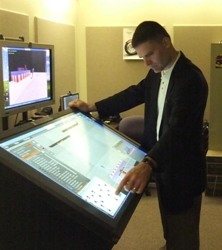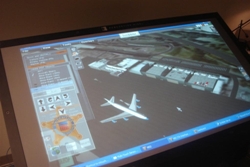
Chemical releases, suicide bombers, air and subsurface threats: the U.S. Secret Service needs to be prepared to handle these real-life incidents. Training to respond to such incidents, however, has been more theoretical than practical. Now, with the help from the Department of Homeland Security (DHS) Science & Technology Directorate (S&T), the Secret Service is giving training scenarios a high-tech edge: moving from static tabletop models to virtual kiosks with gaming technology and 3D modeling.
For the past 40 years, a miniature model environment called “Tiny Town” has been one of the methods used to teach Secret Service agents and officers how to prepare a site security plan. The model includes different sites -- an airport, outdoor stadium, urban rally site and a hotel interior -- and uses scaled models of buildings, cars and security assets. The scenario-based training allows students to illustrate a dignitary’s entire itinerary and accommodate unrelated, concurrent activities in a public venue. Various elements of a visit are covered, such as an arrival, rope line or public remarks. The class works as a whole and in small groups to develop and present their security plan.
Enter videogame technology. The Secret Service’s James J. Rowley Training Center near Washington, D.C., sought to take these scenarios beyond a static environment to encompass the dynamic threat spectrum that exists today, while taking full advantage of the latest computer software technology. The agency’s Security and Incident Modeling Lab wanted to update Tiny Town and create a more relevant and flexible training tool.

With funding from DHS S&T, the Secret Service developed the Site Security Planning Tool (SSPT), a new training system dubbed “Virtual Tiny Town” by instructors, with high-tech features:
- 3D models and game-based virtual environments
- Simulated chemical plume dispersion for making and assessing decisions
- A touch interface to foster collaborative, interactive involvement by student teams
- A means to devise, configure, and test a security plan that is simple, engaging, and flexible
- Both third- and first-person viewing perspectives for overhead site evaluation and for a virtual “walk-through” of the site, reflecting how it would be performed in the field.
The new technology consists of three kiosks, each composed of a 55” Perceptive Pixel touch screen with an attached projector and camera, and a computer running Virtual Battle Space (VBS2) as the base simulation game. The kiosks can accommodate a team of up to four students, and each kiosk’s synthetic environment, along with the team’s crafted site security plan, can be displayed on a large wall-mounted LED 3D TV monitor for conducting class briefings and demonstrating simulated security challenges.
In addition to training new recruits, SSPT can also provide in-service protective details with advanced training on a range of scenarios, including preparation against chemical, biological or radiological attacks, armed assaults, suicide bombers and other threats.
Future enhancements to SSPT will include modeling the resulting health effects and crowd behaviors of a chemical, radiological or biological attack, to better prepare personnel for a more comprehensive array of scenarios and the necessary life-saving actions required to protect dignitaries and the public alike.
The Site Security Planning Tool development is expected to be completed and activated by spring 2011.
To request more information about this story, please e-mail st.snapshots@hq.dhs.gov.
